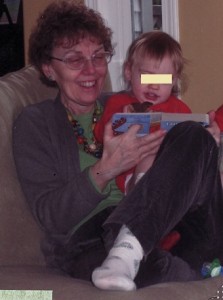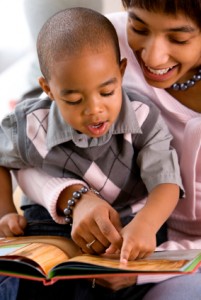Helping Children Learn to Play with Books
We don’t usually think of books as toys but they are great to play with, once children know how. For such toys as balls or blocks, children easily discover ways they can play, but for books, we need to participate with children many times.
 Playing with kids and books is more than just reading the story. For very young children, we may at first only get to read a page or two anyway. Books for this stage have big colorful pictures and very few words. We can play with kids by pointing to the picture, asking, “What’s that?” and then saying the word. Wee ones often try to say the word too or at least comment. Sometimes, they will choose books to play with by themselves, turning the pages and checking a picture or two.
Playing with kids and books is more than just reading the story. For very young children, we may at first only get to read a page or two anyway. Books for this stage have big colorful pictures and very few words. We can play with kids by pointing to the picture, asking, “What’s that?” and then saying the word. Wee ones often try to say the word too or at least comment. Sometimes, they will choose books to play with by themselves, turning the pages and checking a picture or two.
 Toddlers may sit for favorite stories with a few words per page. We can ask more questions about the pictures and make comments. Some books will be interactive with textures to feel, flaps to life, and buttons to press for animal and other sounds. Kids will ask us to read particular stories over and over until they can say the whole book by heart.
Toddlers may sit for favorite stories with a few words per page. We can ask more questions about the pictures and make comments. Some books will be interactive with textures to feel, flaps to life, and buttons to press for animal and other sounds. Kids will ask us to read particular stories over and over until they can say the whole book by heart.
When children are able to sit for longer books, we can extend the ways to play with a story:
- For instance, in a book they’ve heard a gazillion times, we can make a mistake and say the wrong word. Kids love to correct adults and tell us the right word.
- As we’re reading, we can pause and let the child fill in the blank.
- Some books have a rhyming text so we can play with the sounds of words. In the story of the gingerbread man, you might ask, “What else sounds like man, can, ran? Pan sounds like that.” (Until about the age of 4, most children have not figured out rhyming but we can provide lots of experiences so they do.)
- Talk about the story and ask questions. This helps your child connect his or her experiences and add to the meaning. After reading Pat the Bunny ask a child if daddy has a scratchy beard like the daddy in the book.
- When reading a new book, after a few pages, ask your child to predict what might happen next. To make even a rough guess, kids need to connect what has happened so fir in the story to their own knowledge. This requires lots of complicated thinking so it’s a sort of brain gym.
- Besides story books, share some fact books. Children ave absolutely no experience of dinosaurs but some preschoolers will know amazing facts and a long list of hard to say names. Much of this has come from books that parents and caregivers have found and shared.
These are just a few ways that we can use to show–and tell–kids how to play with books. This adds to both their enjoyment and learning as they play. Does your child know how to play with books?
